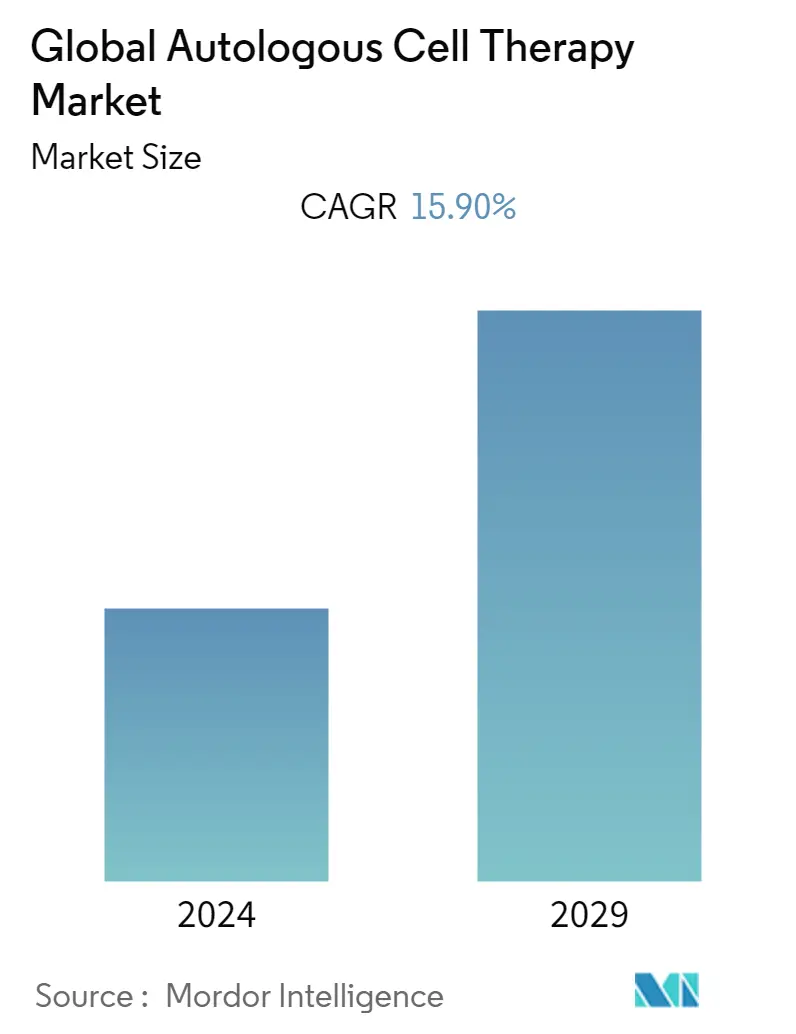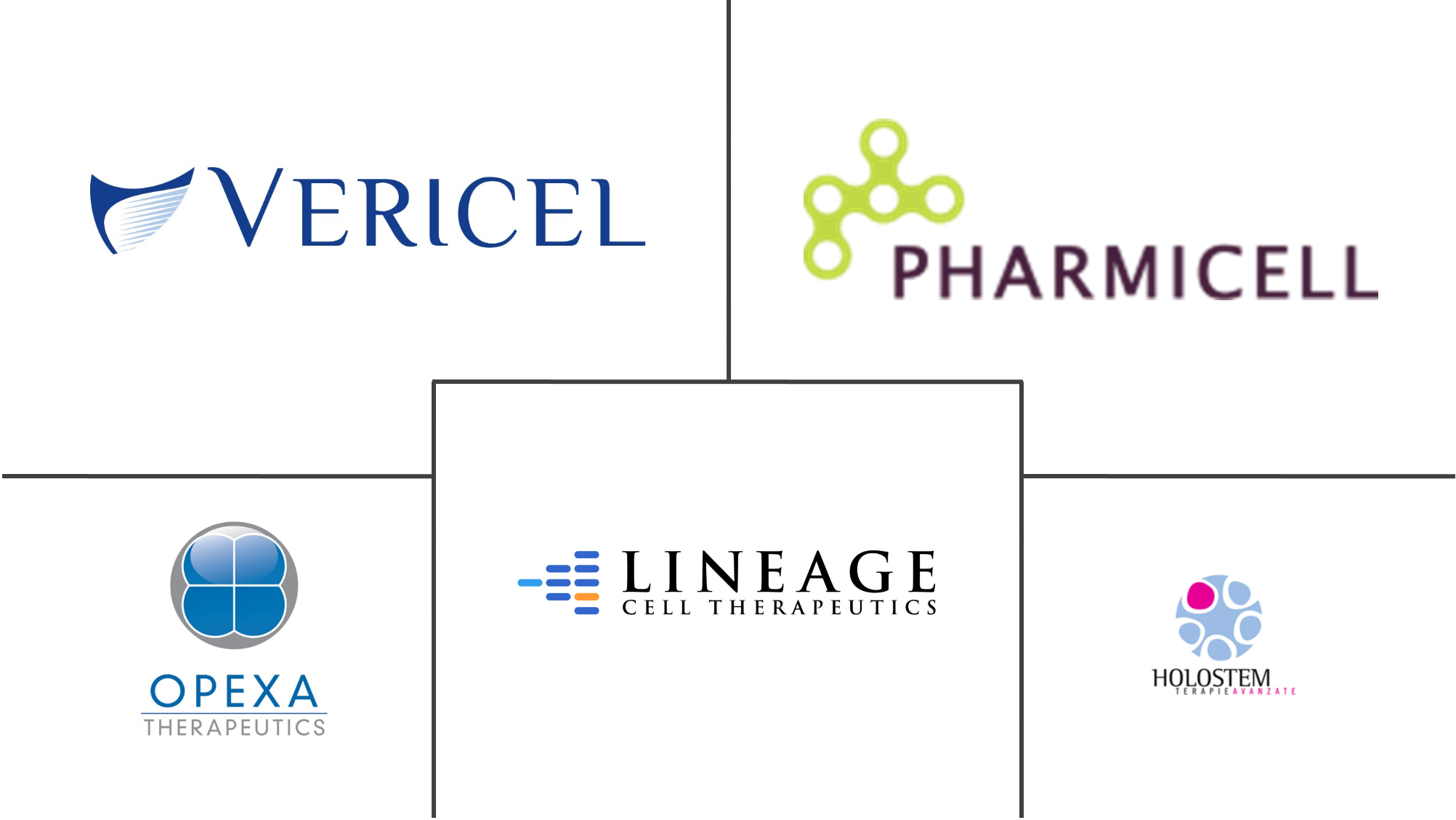Market Size of Global Autologous Cell Therapy Industry

| Study Period | 2019 - 2029 |
| Base Year For Estimation | 2023 |
| Forecast Data Period | 2024 - 2029 |
| CAGR | 15.90 % |
| Fastest Growing Market | Asia Pacific |
| Largest Market | North America |
Major Players
*Disclaimer: Major Players sorted in no particular order |
Autologous Cell Therapy Market Analysis
The Autologous Cell Therapy market studied was anticipated to grow with a CAGR of 15.9%, during the forecast period.
The growth of the market is attributed to the rising number of clinical trials and the growing adoption of cell therapies globally. In the context of COVID-19, government organizations in various countries, research institutes, and many biotech and pharmaceutical firms are focusing on effective and rapid technologies for the fast diagnosis of COVID-19. Additionally, the increasing clinical trials for using the treatment of COVID-19 using autologous cell therapies are expected to contribute to the growth of the market. For instance, as per the clinical trails.gov in 2022, A clinical study was started from January 2020 to March 2021 to study the population of all Swedish Citizens treated with autologous hematopoietic stem cell transplantation for COVID-19 positive patients. The positive results from such studies can lead to the development of new therapies for COVID-19 and thus can propel the growth of the market.
The major factors attributing to the growth of the autologous cell therapy market are the rising incidence of chronic diseases such as autoimmune diseases, cancer, a blood disorder, and others. A rise in the population suffering from chronic diseases is also propelling the demand for market growth. As per the report of the International Agency for Research on Cancer published GLOBOCAN 2020 report which estimated the incidence of 36 cancer in 185 countries, globally, there were an estimated 19,292,789 new cases of cancer diagnosed in 2020 all over the world. Of the total diagnosed cancer cases, 10,065,305 cases were reported in males and 9,227,484 cases were reported in females. the incidence of cancer cases in males was expected to reach 15,585,096 by 2040 and 13,302,846 in females by 2040. Such an increasing incidence of cancer among the global population is expected to drive the growth of the market. Common chronic blood disorders include anemia, bleeding disorders such as hemophilia and blood clots, and blood cancers such as leukemia, lymphoma, and myeloma. As per the May 2022 update by the Center for Disease Control and Prevention, sickle cell disease (SCD) affects approximately 100,000 Americans. It occurs among about 1 out of every 365 Black or African American births. Effective treatment is the best way to protect the life of a patient with blood cell disorder. And other factors are playing crucial roles in taking the autologous cell therapy market to the next level, among them are ongoing drug developments for new applications which are expected to further propel the growth of the autologous cell therapy market. The growth of the market is attributed to the rising number of clinical trials and the growing adoption of cell therapies globally in the forecast period.
However, systemic immunological reactions possibility and expensive practise, product and high capital investment are expected to restrain the growth of the market over the forecast period.
Thus the above-mentioned factors are expected to drive the growth of the market during the forecast period.
Autologous Cell Therapy Industry Segmentation
As per the scope of the report, autologous cell therapy (ACT) is a groundbreaking therapy that uses the cells of an individual that are grown and expanded outside of the body and reintegrated into the donor. The autologous cell therapy market is segmented by Therapy (Autologous Stem Cell Therapy and Autologous Cellular Immunotherapies), Application (Oncology, Musculoskeletal Disorder, Blood Disorder, Autoimmune Disease and Others), Source (Bone Marrow, Epidermis and Others), End User (Hospitals, Research Centers and Others), and Geography (North America, Europe, Asia-Pacific, Middle East and Africa, and South America). The market report also covers the estimated market sizes and trends for 17 different countries across major regions, globally. The report offers the value (in USD million) for the above segments.
| By Therapy | |
| Autologous Stem Cell Therapy | |
| Autologous Cellular Immunotherapies |
| By Application | |
| Oncology | |
| Musculoskeletal Disorder | |
| Blood Disorder | |
| Autoimmune Disease | |
| Others |
| By Source | |
| Bone Marrow | |
| Epidermis | |
| Others |
| By End User | |
| Hospitals | |
| Research Centers | |
| Others |
| Geography | ||||||||
| ||||||||
| ||||||||
| ||||||||
| ||||||||
|
Global Autologous Cell Therapy Market Size Summary
The autologous cell therapy market is poised for significant growth, driven by an increasing number of clinical trials and the global adoption of cell therapies. The market's expansion is further bolstered by the focus on rapid diagnostic technologies for COVID-19, with numerous studies exploring the use of autologous cell therapies in treatment. The rising incidence of chronic diseases, including autoimmune disorders, cancer, and blood disorders, is a major factor propelling market demand. The prevalence of these conditions necessitates effective treatment solutions, with autologous cell therapies emerging as a promising option. Additionally, ongoing drug developments and innovative applications are expected to further enhance market growth, despite challenges such as systemic immunological reactions and high capital investment requirements.
The musculoskeletal disorders segment is anticipated to drive demand for autologous cell therapy, as the global population experiences a rise in such conditions. The increasing prevalence of musculoskeletal disorders, particularly low back pain, underscores the need for effective therapies, contributing to market growth. North America is expected to dominate the market, supported by advanced healthcare infrastructure and a high incidence of chronic diseases. The region's growing geriatric population and the prevalence of conditions like cancer and leukemia further fuel demand for autologous cell therapies. The market is moderately competitive, with major players like Vericel Corporation and Opexa Therapeutics leading the way through strategic acquisitions and partnerships. Recent initiatives, such as Aspen Neuroscience's patient screening study and TreeFrog Therapeutics' research funding, highlight ongoing advancements in the field, promising continued market expansion.
Global Autologous Cell Therapy Market Size - Table of Contents
-
1. MARKET DYNAMICS
-
1.1 Market Overview
-
1.2 Market Drivers
-
1.2.1 Rising Incidence of Chronic Diseases
-
1.2.2 Emphasis Increasingly on Drug Development for New Applications
-
-
1.3 Market Restraints
-
1.3.1 Systemic immunological reactions possibility
-
1.3.2 Expensive practise, product and high capital investment
-
-
1.4 Porter's Five Force Analysis
-
1.4.1 Threat of New Entrants
-
1.4.2 Bargaining Power of Buyers/Consumers
-
1.4.3 Bargaining Power of Suppliers
-
1.4.4 Threat of Substitute Products
-
1.4.5 Intensity of Competitive Rivalry
-
-
-
2. MARKET SEGMENTATION (Market Size by Value - USD million)
-
2.1 By Therapy
-
2.1.1 Autologous Stem Cell Therapy
-
2.1.2 Autologous Cellular Immunotherapies
-
-
2.2 By Application
-
2.2.1 Oncology
-
2.2.2 Musculoskeletal Disorder
-
2.2.3 Blood Disorder
-
2.2.4 Autoimmune Disease
-
2.2.5 Others
-
-
2.3 By Source
-
2.3.1 Bone Marrow
-
2.3.2 Epidermis
-
2.3.3 Others
-
-
2.4 By End User
-
2.4.1 Hospitals
-
2.4.2 Research Centers
-
2.4.3 Others
-
-
2.5 Geography
-
2.5.1 North America
-
2.5.1.1 The United States
-
2.5.1.2 Canada
-
2.5.1.3 Mexico
-
-
2.5.2 Europe
-
2.5.2.1 Germany
-
2.5.2.2 United Kingdom
-
2.5.2.3 France
-
2.5.2.4 Italy
-
2.5.2.5 Spain
-
2.5.2.6 Rest of Europe
-
-
2.5.3 Asia-Pacific
-
2.5.3.1 China
-
2.5.3.2 Japan
-
2.5.3.3 India
-
2.5.3.4 Australia
-
2.5.3.5 South Korea
-
2.5.3.6 Rest of Asia-Pacific
-
-
2.5.4 Middle East and Africa
-
2.5.4.1 GCC
-
2.5.4.2 South Africa
-
2.5.4.3 Rest of Middle East and Africa
-
-
2.5.5 South America
-
2.5.5.1 Brazil
-
2.5.5.2 Argentina
-
2.5.5.3 Rest of South America
-
-
-
Global Autologous Cell Therapy Market Size FAQs
What is the current Global Autologous Cell Therapy Market size?
The Global Autologous Cell Therapy Market is projected to register a CAGR of 15.90% during the forecast period (2024-2029)
Who are the key players in Global Autologous Cell Therapy Market?
Vericel Corporation, Pharmicell Co., Inc., Holostem Terapie Avanzate S.r.l., Opexa Therapeutics and Lineage Cell Therapeutics, Inc. are the major companies operating in the Global Autologous Cell Therapy Market.

